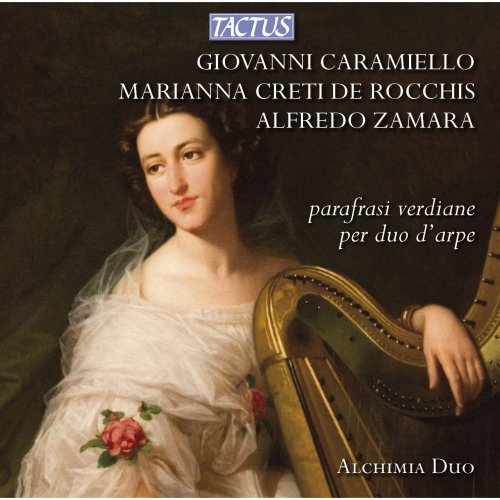
Alchimia Duo - Rocchis, Caramiello & Zamara: Parafrasi Verdiane per duo d’arpe (2014)
BAND/ARTIST: Alchimia Duo
- Title: Rocchis, Caramiello & Zamara: Parafrasi Verdiane per duo d’arpe
- Year Of Release: 2014
- Label: Tactus
- Genre: Classical
- Quality: FLAC (tracks + booklet)
- Total Time: 1:05:07
- Total Size: 261 MB
- WebSite: Album Preview
Tracklist:
01. Fantasia on "Come rugiada al cespite", Op. 13 (After Verdi's Ernani)
02. Potpourri on motifs, Op. 14 (After Verdi's Ernani)
03. Duetto sugli Ernani per due Arpe
04. Divertissement (After Verdi's Luisa Miller)
05. Divertissement (After Verdi's Rigoletto)
01. Fantasia on "Come rugiada al cespite", Op. 13 (After Verdi's Ernani)
02. Potpourri on motifs, Op. 14 (After Verdi's Ernani)
03. Duetto sugli Ernani per due Arpe
04. Divertissement (After Verdi's Luisa Miller)
05. Divertissement (After Verdi's Rigoletto)
The enormous popularity of the opera gave rise to the tradition of transcribing the public’s favourite arias in order to make it possible for them to be performed by a limited number of musicians: the need was felt to reproduce the magic of the theatre by means of one or two instruments, ranging from those available in the bourgeois drawing-rooms of that period to the lowly barrel organs in the streets.
As the role of the harp in the orchestra gradually became established, and increasingly important passages began to be entrusted to it, from the first years of the nineteenth century onwards all major composers included the harp among the instruments for which their pieces were meant, assigning it a solo part in the accompaniment of a voice or of other melodic instruments. This “operatic legacy” also promoted the introduction of the harp into the so-called “drawing-room music”: the enthusiasm for Verdi’s operas was so overwhelming as to stimulate a great number of musicians to compose fantasias, pot-pourris and divertissements on the themes of the most celebrated arias: pieces of this type form a considerable part of the nineteenth-century harp repertoire, and have become milestones in the history of this instrument.
As the role of the harp in the orchestra gradually became established, and increasingly important passages began to be entrusted to it, from the first years of the nineteenth century onwards all major composers included the harp among the instruments for which their pieces were meant, assigning it a solo part in the accompaniment of a voice or of other melodic instruments. This “operatic legacy” also promoted the introduction of the harp into the so-called “drawing-room music”: the enthusiasm for Verdi’s operas was so overwhelming as to stimulate a great number of musicians to compose fantasias, pot-pourris and divertissements on the themes of the most celebrated arias: pieces of this type form a considerable part of the nineteenth-century harp repertoire, and have become milestones in the history of this instrument.
As a ISRA.CLOUD's PREMIUM member you will have the following benefits:
- Unlimited high speed downloads
- Download directly without waiting time
- Unlimited parallel downloads
- Support for download accelerators
- No advertising
- Resume broken downloads


